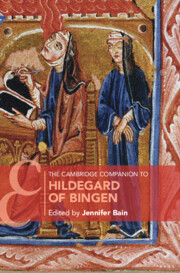Book contents
- The Cambridge Companion to Hildegard of Bingen
- The Cambridge Companion to Hildegard of Bingen
- Copyright page
- Dedication
- Contents
- Figures
- Tables
- Music Examples
- Contributors
- Acknowledgments
- Introduction
- Part I Life and Monastic Context
- Part II Writings and Reputation
- Part III Music, Manuscripts, Illuminations, and Scribes
- Select Bibliography
- Index
- Cambridge Companions To …
- References
Part II - Writings and Reputation
Published online by Cambridge University Press: 28 October 2021
- The Cambridge Companion to Hildegard of Bingen
- The Cambridge Companion to Hildegard of Bingen
- Copyright page
- Dedication
- Contents
- Figures
- Tables
- Music Examples
- Contributors
- Acknowledgments
- Introduction
- Part I Life and Monastic Context
- Part II Writings and Reputation
- Part III Music, Manuscripts, Illuminations, and Scribes
- Select Bibliography
- Index
- Cambridge Companions To …
- References
Summary

- Type
- Chapter
- Information
- The Cambridge Companion to Hildegard of Bingen , pp. 83 - 206Publisher: Cambridge University PressPrint publication year: 2021



